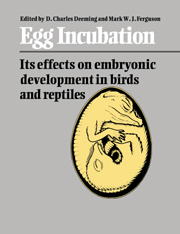Book contents
- Frontmatter
- Contents
- Preface
- Contributors
- 1 Maternal diet, maternal proteins and egg quality
- 2 Comparative composition and utilisation of yolk lipid by embryonic birds and reptiles
- 3 Oviductal proteins and their influence on embryonic development in birds and reptiles
- 4 Fluxes during embryogenesis
- 5 Eggshell structure and formation in eggs of oviparous reptiles
- 6 Shell structure and formation in avian eggs
- 7 Physical characteristics of reptilian eggs and a comparison with avian eggs
- 8 Egg-shape in birds
- 9 The thermal energetics of incubated bird eggs
- 10 Physiological effects of incubation temperature on embryonic development in reptiles and birds
- 11 Cold torpor, diapause, delayed hatching and aestivation in reptiles and birds
- 12 Physical factors affecting the water exchange of buried reptile eggs
- 13 Physiological and ecological importance of water to embryos of oviparous reptiles
- 14 Roles of water in avian eggs
- 15 Water economy and solute regulation of reptilian and avian embryos
- 16 The avian eggshell as a mediating barrier: respiratory gas fluxes and pressures during development
- 17 Gas exchange across reptilian eggshells
- 18 Metabolism and energetics of reptilian and avian embryos
- 19 Reasons for the dichotomy in egg turning in birds and reptiles
- 20 A comparison of reptilian eggs with those of megapode birds
- 21 Why birds lay eggs
- 22 Influences of incubation requirements on the evolution of viviparity
- 23 Overview of early stages of avian and reptilian development
- 24 Ions and ion regulating mechanisms in the developing fowl embryo
- 25 Electrochemical processes during embryonic development
- 26 Methods for shell-less and semi-shell-less culture of avian and reptilian embryos
- 27 Experimental studies on cultured, shell-less fowl embryos: calcium transport, skeletal development, and cardio-vascular functions
- Index
7 - Physical characteristics of reptilian eggs and a comparison with avian eggs
Published online by Cambridge University Press: 16 November 2009
- Frontmatter
- Contents
- Preface
- Contributors
- 1 Maternal diet, maternal proteins and egg quality
- 2 Comparative composition and utilisation of yolk lipid by embryonic birds and reptiles
- 3 Oviductal proteins and their influence on embryonic development in birds and reptiles
- 4 Fluxes during embryogenesis
- 5 Eggshell structure and formation in eggs of oviparous reptiles
- 6 Shell structure and formation in avian eggs
- 7 Physical characteristics of reptilian eggs and a comparison with avian eggs
- 8 Egg-shape in birds
- 9 The thermal energetics of incubated bird eggs
- 10 Physiological effects of incubation temperature on embryonic development in reptiles and birds
- 11 Cold torpor, diapause, delayed hatching and aestivation in reptiles and birds
- 12 Physical factors affecting the water exchange of buried reptile eggs
- 13 Physiological and ecological importance of water to embryos of oviparous reptiles
- 14 Roles of water in avian eggs
- 15 Water economy and solute regulation of reptilian and avian embryos
- 16 The avian eggshell as a mediating barrier: respiratory gas fluxes and pressures during development
- 17 Gas exchange across reptilian eggshells
- 18 Metabolism and energetics of reptilian and avian embryos
- 19 Reasons for the dichotomy in egg turning in birds and reptiles
- 20 A comparison of reptilian eggs with those of megapode birds
- 21 Why birds lay eggs
- 22 Influences of incubation requirements on the evolution of viviparity
- 23 Overview of early stages of avian and reptilian development
- 24 Ions and ion regulating mechanisms in the developing fowl embryo
- 25 Electrochemical processes during embryonic development
- 26 Methods for shell-less and semi-shell-less culture of avian and reptilian embryos
- 27 Experimental studies on cultured, shell-less fowl embryos: calcium transport, skeletal development, and cardio-vascular functions
- Index
Summary
Introduction
Most female oviparous reptiles ovulate and shell a few to several eggs at the same time to produce a clutch that is normally laid as a unit. This differs significantly from the normal procedure in birds, in which individual eggs in a clutch are each ovulated, shelled, and oviposited separately (usually on a 24-hour cycle in the fowl (Gallus gallus); Gilbert, 1971). Egg size and number within a clutch are clearly important aspects of an organism's life history ‘strategy’ (Smith & Frerwell, 1974; Stearns, 1976). Egg size, shape and number also may be related to the anatomy of the female (e.g. ovarian follicle size, oviductal length and diameter, abdominal volume, and size of the pelvic canal), as well as to the physiological ecology of the clutch in the nest. For reptiles, evidence is available that suggests that life history strategies (Moll, 1979; Ferguson, Brown & DeMarco, 1982; Dunham, Miles & Reznick, 1988; Seigel & Ford, 1987; Ford & Seigel, 1989), pelvic canal size (Congdon & Gibbons, 1987; Long & Rose, 1989), and nest physiology (Packard & Packard, 1988) do place important constraints on egg size, shape, and number. However, the influence of the anatomy and physiology of the female reproductive tract on egg parameters has not been explored in reptiles.
Although numerous studies report clutch sizes, lengths and widths of eggs in reptiles, and some even report data on mass, volume, or other aspects of egg-shape, no synthesis of egg size and shape has been attempted for reptiles at the level done for birds, which includes aspects of size, volume, density, surface area, and shape (Preston, 1953, 1969, 1974; Paganelli, Olszowka & Ar, 1974; Tatum, 1975; Rahn, Paganelli & Ar, 1975; Hoyt, 1976; Smart, Chapter 8).
- Type
- Chapter
- Information
- Egg IncubationIts Effects on Embryonic Development in Birds and Reptiles, pp. 87 - 100Publisher: Cambridge University PressPrint publication year: 1991
- 35
- Cited by



